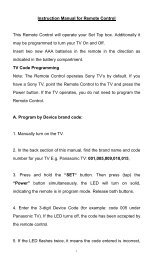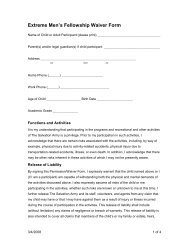Age of Jackson Notes - WOW!
Age of Jackson Notes - WOW!
Age of Jackson Notes - WOW!
- No tags were found...
Create successful ePaper yourself
Turn your PDF publications into a flip-book with our unique Google optimized e-Paper software.
Constitution <strong>Notes</strong>Preamble to the Constitution—Goals1) Form a more perfect union—set up a stronger national government2) Establish Justice—improve the court system, ensure fairness for all3) Insure Domestic Tranquility—peace within the country4) Provide for the common defense—protect the country from foreign enemies5) Promote the general welfare—have good living conditions for citizens6) Secure the blessings <strong>of</strong> liberty to ourselves and our posterity—have freedom for all generations <strong>of</strong> Americans“We the people <strong>of</strong> the United States <strong>of</strong> America”…not the government, a king, or a dictator. We are the government—we decide howthings are run.Constitution—three branches <strong>of</strong> governmentLegislative Branch—a bi-cameral legislature (2 houses) made up <strong>of</strong> the House <strong>of</strong> Representatives (lower house) and Senate(upper house).435 members <strong>of</strong> the House, based on state population100 members <strong>of</strong> the Senate, 2 per state—article onePart <strong>of</strong> the Great CompromiseExecutive Branch—President, Vice-President, and the Cabinet (a group <strong>of</strong> presidential advisors)—article two.Judicial Branch—Headed by the Supreme Court, it also has District and Appeals courts. There are nine supreme court justices,appointed by the President. They serve for life. They must be confirmed by the Senate.Legislative Branch—writes the laws.Executive Branch—signs (or executes) the laws.Judicial Branch—judges the laws (makes sure that laws are Constitutional or follow the Constitution).Checks and Balances—Each branch can check the other from doing certain things. This prevents one branch from getting too strong, IFthe other branches do their jobs.Congress—writes laws and spends money…lots <strong>of</strong> it.House—any spending (tax) bill must start here. They can impeach an <strong>of</strong>ficial (President). They vote by majority rules. They run forelection every two years.Senate—chosen today by popular vote. Serve six-year terms. Rules are different in the Senate, debate can go on forever in theory.One party can filibuster, or prevent a vote from taking place by talking and talking. To end the debate, the Senate must reach cloture—60 members agreeing to vote. The Vice-President breaks all tie votes.Congressional Powers—they have the power to tax, borrow money, regulate trade (make rules on business), coin money, declare war,and build a military.***Elastic Clause*** give Congress the power to do anything “necessary and proper”. This has been stretched beyond belief over theyears.Types <strong>of</strong> Power:Enumerated Powers: specific powers listed in the Constitution that Congress hasImplied Powers: assumed to be allowed by the Constitution (elastic clause)Inherent Powers: powers the government has in order to be able to function
Congressional Powers are Limited. States have specific things that only they are allowed to do. A state law MUST be legal under theConstitution (Constitutional). Congress must also follow the Constitution.Executive BranchPresident and Vice-President are chosen by the electoral college. Each state gets a certain number <strong>of</strong> votes based on their population.Presidential Jobs—Busy man!1) Commander in Chief—in charge <strong>of</strong> all military forces2) Chief Executive—in charge <strong>of</strong> making sure the country runs (head <strong>of</strong> government)3) Chief <strong>of</strong> State—represents the country to the rest <strong>of</strong> the world4) Chief Legislator—sends bills to Congress, signs bills into law or vetoes them.5) Chief <strong>of</strong> Party—head <strong>of</strong> his party (Republican or Democrat)President is the moral authority for the country—he should be a role model for all citizens.Impeachment—a public <strong>of</strong>ficial is <strong>of</strong>ficially accused <strong>of</strong> wrongdoing.--The house must vote to impeach the <strong>of</strong>ficial. If it does, the Senate must hold a trial to determine guilt or innocence. 67 members <strong>of</strong>the Senate must vote guilty for an <strong>of</strong>ficial to be removed.Only two presidents have been impeached—Andrew Johnson (17) and Bill Clinton (42). Both were found not guilty by theSenate in their trials.Presidential Cabinet—a group <strong>of</strong> advisors who help the president. Many different cabinet <strong>of</strong>fices help run different parts <strong>of</strong> thegovernment. The heads <strong>of</strong> each department are known as Secretaries.Judicial Branch—Judges explain or interpret the laws. They determine whether a law passed by Congress or a state isConstitutional.Court cases begin in district court, then move to the Appeals courts, and finally onto the Supreme Court. The Supreme Court has thefinal say—what it says, goes. This is called Judicial Review—court decides whether a law passed is legal or not.Certain cases can go directly to the Supreme Court—anything involving the Constitution, federal laws, treaties, and laws about the sea(naval) can be heard by the court. These are called original jurisdiction cases.Under Appellate Jurisdiction, the court can only hear a case after it has gone through the appeals process. The Supreme Court does nothave to take any case it decides not to.Article IV: The states—this article deals with the rights <strong>of</strong> the states under the Constitution. Each state must respect the rights <strong>of</strong> allother states. Each state must treat a citizen <strong>of</strong> another state equally. Each state must work with the other states to get things done for thegood <strong>of</strong> the country.Article IV also guarantees that the US will not be a monarchy, but a Republic. The government is the people.Article V set up a way to amend or change the Constitution. When it was written, they knew everything was not perfect.Article VI established the Constitution as the Supreme Law <strong>of</strong> the Land <strong>of</strong> the United States. No other laws can come before it(domestic or foreign). Established the sovereignty <strong>of</strong> the US. We run our own country and decide things based on what’s best for us.
















